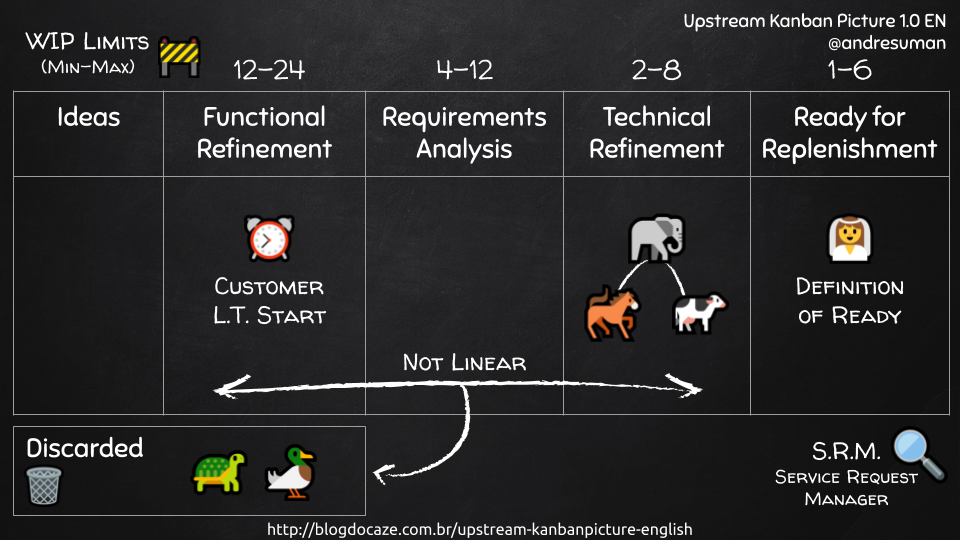Translation review: Caio Cestari
- See also: Kanban Picture
- Repository: Google Drive – Kanban Picture
Permission: Kanban Picture and Upstream Kanban Picture are free to use. Images can be copied and shared.
While in Downstream (delivery) we have work the team has already committed to, in Upstream we have options. The commitment point (when the marriage with demands happens :D) delimits the boundary between Upstream and Downstream.
Our ability to have ideas and generate opportunities is greater than the ability to convert them into done items, which is why Upstream is like a “funnel with filters” where options are analyzed, refined, discarded, studied and selected to be worked on.

Upstream Kanban
Book Essential Upstream Kanban (Patrick Steyaert)
Analysing and managing Upstream and Downstream create a more sustainable, efficient and effective flow from end to end, integrating the development team and business areas.
In the following video (part of the “Upstream Kanban” talk) I explain the image.
Discarded
Options are expected to be discarded at any Upstream stage. While during delivery we avoid “breaking up the marriage”, we consider the Upstream a “dating” that may not work. 🙁
More important than “knowing what to do” is “knowing what not to do” for reasons of cost, value, market changes or simply because it is a bad idea.
WIP Limits (minimum and maximum)
To foster a healthy flow, we must have options available for selection and development into delivery. A minimum limit guarantees that there is always work to be done, while the maximum limit has the same benefits known in downstream – “stop starting, start finishing”.
Refinement
As options are analyzed, they can be broken down into smaller functional items. Epics, features and stories are refined to meet the definition: “Between dogs and camels, all things are animals. You should avoid rats and elephants”. In this analogy, an elephant can be “split” into smaller animals that fit between a horse and a cow – but only whole animals (representing functional items).
Definition of Ready
The workflow (columns) presented in the Upstream Kanban Picture is an example – however, the “Ready for Replenishment” column makes sense in any scenario. Items in this column meet the “Definition of Ready” – that means there is clarity about what should be built. Selection happens on replenishment. “The bride is ready, waiting for the wedding”.
Non-Linear Flow
While in downstream we avoid “moving cards back” on the board, this does not happen in upstream. The need for analysis, refinements and studies means that the upstream flow is not linear. There are forwards and backwards, items being discarded and items being “split” at all times.
Customer Lead Time
This metric represents the number of days between a customer need was captured and the delivery of that request. You should assess at which stage of the work there is a minimal and clear definition that the need really exists – and then you should start counting to understand how long it takes for the request to be fulfilled. The analysis of Customer Lead Time with Delivery Lead Time is fundamental to improve the whole flow of work and customer satisfaction.
Service Request Manager (SRM)
As a suggested role in the Kanban Method, the Service Request Manager manages the upstream workflow and the replenishment cadence. While the Service Delivery Manager (SDM) is more focused on downstream efficiency, SRM acts mainly on the effectiveness of the system, selecting the best functional items to be developed at each moment.
See also:
Questions? Comment the post!

One Reply to “Upstream Kanban Picture (English)”